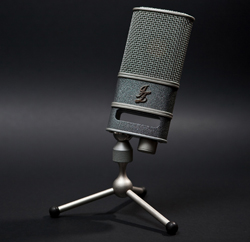
At the 2010 Winter NAMM show, JZ Microphones made available the first microphone in JZ Vintage series, the V47, intended to provide users with the sound of the legendary Neumann U47.
The V47 incorporates a unique double diaphragm capsule and a smart shock-mounting system and swivel mount which works as a perfect positioning option for recording applications.
The capsule uses the company’s proprietary Golden drops sputtering technology to optimize frequency response, and is further enhanced by improved, modern electronics.
“The sound of the 47 capsule is one of the most favorite sounds in the recording industry since the middle of 20th century,” states Juris Zarins of JZ Microphones and designer of the V47. “Even in that time engineers found out quickly that the sensitivity of the 47 sound greatly enhanced the detail of their recordings.
“After many years in microphone business I have the knowledge and technologies to produce capsules appropriate to the highest quality standards. Because we are running out of vintage mics today, our company will offer excellent choice for every engineer to make recordings with well known vintage feel for reasonable price.”
The V47 is covered by a five year warranty.
Specifications
Transducer type: electrostatic
Operating principal: pressure gradient
Diaphragm active diameter: 25 mm
Frequency range: 20 Hz to 20 kHz
Polar pattern: cardioid
Output impedance: 50 ohms
Rated load impedance: 1000 ohms
Suggested load impedance: > 500 ohms
Sensitivity at 1000 Hz into 1000 ohms load: 22 mV/Pa
S/N Ratio CCIR 468-3 weighted: 76 dB
S/N Ratio DIN/IEC 651 A-weighted: 87 dB-A
Equivalent noise level DIN/IEC A-weighted : 6 dB-A
Maximum SPL for 0.5% THD at 1000 ohm load: 134 dB
Dynamic range of the microphone preamplifier: 128 dB
Phantom powering voltage on pins 2 & 3 of XLR: +48 V (+/-4 V)
Current consumption:
< 2 mA
Output connector: 3-pin XLR male, gold plated contacts
Signal polarity: positive toward pressure on a diaphragm produces positive polarity voltage on XLR pin #2 relatively to pin #3
JZ Microphones Website
